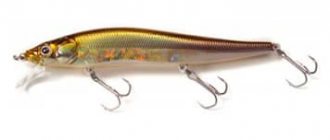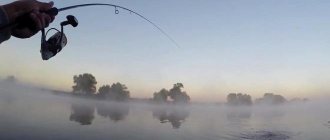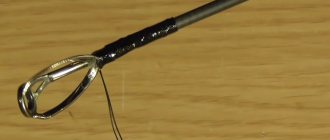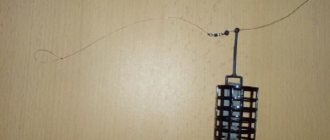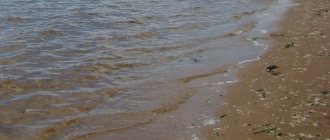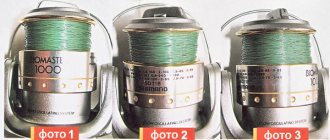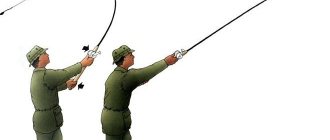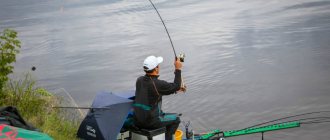How to cast a feeder correctly - casting technique
The overall effectiveness of fishing greatly depends on the accuracy and casting distance. The more accurately you cast the feeder, the denser the feeding spot will form, concentrating more fish in one spot. Before performing a power cast with a feeder rod, you need to tighten the clutch, otherwise you can injure your finger. Well, the casting technique itself is as follows:
- We take the feeder rod with both hands. Right-handed: hold the end of the rod with your left hand, and grab the place at the level of the reel with your right hand.
- Using the index finger of your right hand, fix the fishing line or braid
- Press the line or braid with your index finger to the rod
- With your left hand, remove the line guide arc of the reel.
- We pull the feeder back over the shoulder (right), the overhang of the feeder should be from 20 to 50 centimeters.
- The left arm straightens at the same time.
- We make a smooth acceleration, bending the left and straightening the right arm. When the rod reaches the “2 o’clock” position, we make the maximum acceleration of the feeder.
- Release your finger from the cord pressed to the feeder. The feeder is flying.
- If you have fixed the clip, then before the feeder falls into the water, you need to set the feeder vertically. This will allow the rod to absorb excess load while tensioning the fishing line or cord. When using the cord, be especially careful and precise.
Try not to overdo it, because an excessively strong cast when using braided fishing line can lead to the shooting of the feeder, or even breakage of the rod.
How to choose a feeder for long casting
When choosing a feeder for long-distance casting, it is worth considering that the length of the throw is influenced by:
- the shape of the inertial reel spool;
- action, rod length;
- quality, diameter of passage rings;
- precisely selected weight of the feeder.
Feeder
The aerodynamic properties of the thrown load, the correctly selected weight and the location of the load affect the range. For example, a bullet-shaped feeder flies further than a metal mesh feeder. This is easy to figure out if you know the simple laws of physics.
fishing line
When choosing it, you need to take into account the stretchability. More experienced fishermen use a cord for rigging, but if cast incorrectly, it can simply break the top of the rig. Medium stretch monofilament string works great.
Coil
The casting distance of a reel is mainly influenced by the shape of the spool. For long casts it is better to use a low profile spool. Reels with aluminum spools are considered the best; their sides are as smooth as possible, and the surface offers less resistance when the line or cord moves. For example, "Long Cast" are shaped like a cone. The sides of such a reel are smoother, due to this the line has less sail and glides easier.
The spools of a spinning reel with a larger diameter will be better in quality, because... Logically, a larger reel has fewer turns of line and less friction.
Rod build
Feeder rods come in two types:
The difference between them is the bending of the main part. Fast (translated from English as “quickly”) unbends faster, sending the load into the water with less force. Slow - slow, unbends for a long time and pushes the feeder forward with greater force. The price of rods made of the same material, from the same company, will vary greatly due to the difference in the increase in applied force.
Passing rings
The casting range of the feeder reel depends on the following parameters of the guide rings:
- diameter of forms;
- arrangement of forms;
- the material from which they are made.
Passage rings are those elements of the equipment through which the fishing line passes and constantly rubs. They must be made of wear-resistant material. During the casting process, friction occurs, which causes heat. This is especially noticeable when using a cord, so you should give preference to the following materials:
- aluminum;
- metal ceramics with silicon coating.
The location and diameter of the rings play a smaller, but still important role. The most successful arrangement is to install large rings at the beginning and smaller ones at the end. Manufacturers claim that this increases the range of the gear.
The influence of feeder price on casting distance
Above, we examined the design of the feeder reel in detail, and from the description we can conclude: when choosing equipment for long-distance casts, you need to carefully select the rod, reel and fishing line. The range of throws directly depends on their quality, and a high-quality product cannot be cheap. But it is quite acceptable for a novice fisherman to save on materials, because... there is a high probability of breakdowns and damage to parts of the fishing rod.
Where to throw feeder equipment?
To successfully fish in a certain place, you need to have fish there. And in order to find the target fish, you need to know its promising locations.
Promising places for fishing primarily include areas of the bottom with a significant difference in depth: holes, edges, riffles, stones.
The fisherman’s task, at the initial stage of fishing in an unfamiliar body of water, is to study the bottom and find interesting places. Moreover, this can be done even without the use of a technological echo sounder.
Feeder fishing technique: correct casting.
Feeder for beginners: casting technique.
Feeder fishing
- First you need to properly assemble the feeder. In such a way that all the access rings lined up in one line. If the rings fall out of this line at the time of casting, the fishing line or braided cord may become tangled.
- We reel our feeder or weight at a distance of approximately 1-1.5 meters from the quiver tip for a rod 3.6 meters long (but not more than half the length of the rod). A very large or small plumb of the feeder will negatively affect casting. Sometimes, when the vegetation does not allow this, you have to abandon it with some inconvenience.
- When casting, we take the blank with our right hand so that the reel leg passes between our middle and ring fingers. In this position, it will be convenient for you not only to hold the form itself, but also to hold the fishing line after retracting the line handler.
- With the index finger of your right hand, grab the line without pressing it to the rod, and with your left hand we move the bow away.
- With a smooth movement we place the rod behind the head, checking that our equipment does not get caught. When you master this, everything will work out automatically for you.
- Then we cast. Casting is carried out with a movement from smooth to sharp. At the same time, when the angle of the rod with the horizon is 45-50 degrees, we release our fishing line. This angle is determined by the physics of the process. From physics lessons we know that a load thrown at an angle flies a greater distance if this angle is exactly 45 degrees.
- After casting, but before the feeder enters the water, the feeder returns to the vertical position. This is done to compensate for the jerk if you put the fishing line into the clip.
- We close the line guide handle and place the feeder on the stand. We are watching for future bites!
Necessary conditions for quality casting
As soon as you have acquired feeder tackle, you have to master a number of very important points in fishing with this method, and in the first place is casting the feeder. It’s best to start training by attaching lead weights to your main line rather than feeders, as they are cheaper and you won’t feel so sorry for them if they come off. The next important point is to pay close attention to ensuring that when assembling the rod, all the rings in the blank are placed correctly in one line, and there are no distortions, because they greatly affect the line yield and the flight range of the equipment.
It is recommended to equip your first reel on your first feeder rod with a monofilament line of medium elongation. Unlike braided cord, which has an inextensible and rigid structure, it forgives inexperienced anglers some mistakes, both when casting and when catching large fish.
I would like to note a couple more nuances for beginning anglers, namely that it is best to master this style of fishing with a rod 360 centimeters long, the reel for such a form is most often optimal in size 4000, and the diameter of the first monofilament in the spool is more suitable 0.22 millimeters.
We fix the casting distance
Before casting the equipment, we need to identify promising points. This could be a dump, an area behind the edge, a shell rock, or an exit from a hole. We will learn how to determine such points in a separate article.
After determining the point, you need to fix the line at the required distance so that it does not unwind from the spool more than necessary. This is done in order not to throw the equipment over the point. There are several ways to fix the line. The simplest is to put the fishing line in the clip, as shown in the figure:
The disadvantage of this method is that there may be problems when biting serious specimens. In such cases, there may be misalignments, since the clutch is not an assistant in this case. It will start working if we manage to reel in the fishing line at least 10 meters. If the fish starts to tear the tackle from the start, then breaking the leader is very possible.
To protect yourself from such annoying moments, it is better to use a rubber band. It is put on as follows:
If the fish pulls strongly, the line will come off and the clutch will work. After fixing the fishing line, you need to take a marker that is different in color from the fishing line and mark the place of fixation. This way, even if the line moves, we can easily restore the fishing distance.
Sequence of actions when casting
It is very important to check how freely the line comes off the reel before each cast. First, we throw the bow off the reel and clamp the line to the blank, as shown in the figure:
We press down the line with our index finger and see how freely it moves. If we feel a tight move, be sure to inspect the line in the area of the tip. It often happens that it overlaps with the top and needs to be corrected. If this is not done, then when casting, shooting will occur and we will lose the feeder. This is still a light version. It will be worse when the top breaks.
If there are no overlaps, then place the rod behind your back and make sure that the distance from the tip of the rod to the feeder is about a meter by a meter. The picture shows the moment of winding the rod behind your back:
We see that the right hand holds the reel and is above the head. The left one holds the end of the rod and is in an extended position. Thus, when casting, the rod is located almost parallel to the ground. This is how medium and long casts are performed. When casting at close distances, the rod can be held almost perpendicular to the shore.
After this, we make a sharp cast towards the previously planned landmark. After casting, hold the rod parallel to the shore, strictly in the direction of the flying loop. As soon as the feeder reaches the surface of the water, we lift the rod up, perpendicular to the shore. Thus, we absorb the load that falls on the clip or elastic band. After the line is unwinded to the place where it is fixed with a clip or elastic band, a characteristic sound will follow. With such casts, no large arc is formed and there is practically no need to reel in the fishing line; two or three turns of the reel are enough. It is very important to cast accurately so that there are no deviations to the side.
How to make an accurate cast
After you have mastered the initial stage of sending the rig into the water, you need to learn how to throw accurately. But two conditions will help us exactly:
- This is a clearly visible landmark on the opposite bank, which will remain motionless throughout the entire fishing trip, for example: a tree, building, power pole, etc. You should not target people or vehicles, as they may move during fishing.
- This is the so-called “clipping”, when, after casting to the fishing point of your choice, the line is wound behind a clip on the reel spool, thereby limiting the flight range of the equipment. And you will no longer cross the intended point, but will end up in one place.
- It is worth paying attention to the fact that casting with a feeder must be carried out constantly from the same point, be it a chair, a feeder platform, or simply your footprints on the shore. In this way, we reduce the likelihood of large deviations in accuracy.
How to learn to throw accurately?
To throw accurately, you need to practice as much as possible. The more casts you make, the faster you will learn this business. Alternatively, you can use the Stadium method. It’s not true, many fishermen, when making their first casts, heard a lot of “compliments” addressed to them from the fishermen sitting next to them. And among these phrases there was a proposal to go to the stadium and practice throwing there.
There is a rational grain in this seemingly joke. If near your house there is a playground or stadium, or a clearing at least 60 meters in size, then why not try throwing. You can take, for example, a meter-long hoop and place it first at a distance of 30 meters, then 40, then 50, and so on. By throwing from various distances into this hoop, you can train your throws and gain confidence that it turns out that it is not so difficult for the feeder to throw the feeder with an accuracy of up to a meter. We do everything the same way as on a pond: we clip on and select a landmark and throw until all the feeders fall exactly into the hoop.
On the pond we only consolidate the acquired skill. On the river it will be easier to determine the casting distance by eye. By fixing the fishing line and throwing at the same landmark, we will cast our feeder with an accuracy of 20-30 centimeters.
Technique for casting a feeder to one point
First of all, you need to know which side to approach the rod from, how to hold it, where to point it, and so on. If this is a dark forest for you, check out. Again, there is nothing complicated about it - anyone can learn. If you know all this, you can proceed to casting exactly to the right place. Moreover, it is carried out literally in two or three stages.
The feeder is thrown into the same place as follows:
- Find a landmark with your eyes and direct the feeder a little further than the catch point that you remember.
- Reel in the reel a little at a time until you get to exactly the casting location that you outlined earlier.
- Secure your main line to the spool with an elastic band (the easiest way is to take a regular stationery one).
- Now, when casting, the line will unwind only to a certain limit - to the point you choose.
- Start feeding - make 5-8 frequent casts with an interval of 25-30 seconds, and you will see that each of them goes to the same place.
As you can see, solving the issue of accuracy in practice is not difficult. This is an easy task even for a novice feeder - so go ahead, look for a catchable place, feed it and fish out worthy prey.
fider.su
How to make ultra-long casts?
To make ultra-long casts, you need to use the carp fishing technique. When casting, move the rod slightly lower than in the figure shown above. Arms must be extended to their full length. We make a power throw, so we need to take a short run-up, 3-4 steps, and accelerate in the last phase of the swing, when we bring the rod parallel to the shore. In this case, we shift the center of gravity from one leg to the other. It looks like this:
Let us add that the casting distance is largely influenced by the test of the rod. It is much easier to make ultra-long casts with rigid rods such as heavy and extra-heavy. Such fishing rods can be thrown a hundred meters away. However, in this case, sometimes it still makes sense to think about another place. It is not always comfortable to fish at such a distance. In some cases, this distance is the only promising one. Therefore, you need to be able to throw 100 meters.
It is important that there is space on the shore and that there are no plants or trees behind. If there is a minimal area for a short run, then this is very good. It is advisable to wear sneakers or other tight-fitting shoes on your feet. This way you can avoid unpleasant surprises when casting.
The casting distance depends on how full the spool is with fishing line. Ideally, the distance from the fishing line to the edge of the side is 2-3 mm, as we see in the figure:
The line will come off the spool easily, and it will not get tangled when casting.
Follow us on social networks
— through them we publish a lot of interesting information, photos and videos.
Popular sections of the site:
The fisherman's calendar will allow you to understand how all the fish bite depending on the time of year and month.
The fishing gear page will tell you about many popular gear and devices for fishing.
Fishing baits - we describe in detail live, plant, artificial and unusual ones.
In the bait article you will get acquainted with the main types, as well as tactics for using them.
Learn all the fishing lures to become a real fisherman and learn how to choose the right one.
